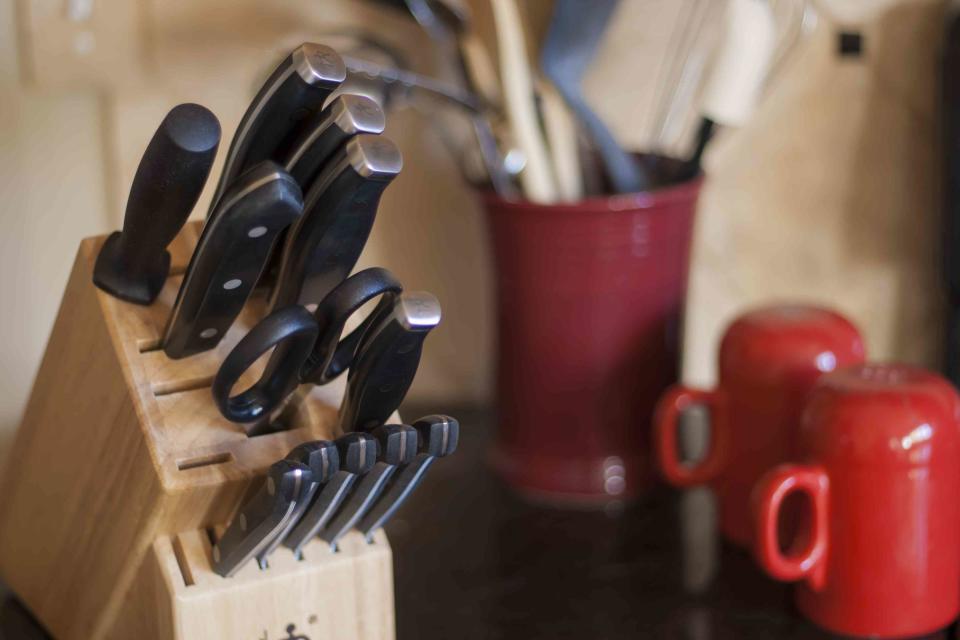Why You Should Clean Your Knife Block ASAP—Plus How to Do It
Kitchen experts weigh in on the best ways to keep your knife block clean and bacteria-free.

If you have a knife block, it’s probably something you use every time you cook. If you’re more of a take-out person, at the very least you see the decorative-yet-functional kitchen accessory on the countertop and don’t give it a second thought—but maybe you should. It turns out, those tiny little slots are likely harboring bacteria, which then goes into your food each time you slice a tomato or chop an onion.

The good news is, there are ways to keep your knife block clean and bacteria-free. Here’s what the experts have to say.
Related: How Often Should You Clean Your Kitchen Appliances?
Are Knife Blocks Actually That Dirty?
As long as you aren’t placing dirty knives back into the knife block, it shouldn’t be that dirty—right? It turns out, even clean knives can harbor bacteria inside those tiny slots. We talked to Alexis Novacek, ZLINE home market expert, to find out why—and learn what to do about it.
Novacek explains that knife blocks can become very dirty without proper maintenance. It’s crucial to dry off knives before storing them in a block, which is a step most people don’t realize is necessary.
“Placing wet knives back into the block can create mold, posing a hazard for your kitchen that can be difficult to remove,” Novacek says.

BHG / Sydney Saporito
How to Deep-Clean Knife Blocks
Novacek suggests following these steps to deep clean your knife block.
1. Clean the Slots
“Take all the knives out. Pick up your block, turn it over, and shake out any crumbs,” Novacek says. “Turn it back right-side up and use a pipe cleaner to get into those slots if you think there are residual crumbs lodged in there.”
2. Clean the Outside
Then, clean the outside of the block with soapy water. Novacek recommends using a scrubby sponge or brush, soap, and water to gently scrub the outside of the block.
“Avoid using too much water—moisture is why you have mold and bacteria in the first place,” he says.
When finished, wipe down the block with a clean, damp cloth. If there’s excess moisture or soapy residue, use a scraper to remove it.
“Grab a wood scraper and run it along all the sides of your block. Then, wipe down the block again with another clean, dry cloth, ensuring that all excess moisture is removed,” Novacek says.
3. Use a Bleach Solution
After the block is done drying, preferably overnight, mix up a solution of one teaspoon of bleach and four cups of water.
“Clean the outside of the wooden block with a scrub brush and the diluted bleach solution,” Novacek says.
Use a pipe cleaner dipped in bleach solution to clean each one of the slots. Then wipe it down again with a damp cloth and let it dry completely for at least 12 hours.
How to Prevent Your Knife Block from Getting Dirty
Once you’ve gone to all the work to clean your knife block, you’ll want to make sure it stays that way. Here are a few suggestions for making that happen.
Choose the Right Block
“Certain types of wooden blocks can offer added protection,” Novacek says. “With ZLINE, our block is constructed with professional quality Acacia wood, which is highly water-resistant and durable, providing great protection from bacteria.”
If you’re shopping for a knife block and it looks cracked, cheap, or if the type of wood isn’t noted on the packaging, it’s a smart idea to choose something else.
Related: The 10 Best Kitchen Knife Sets of 2023 for Home Cooks of All Skill Levels
Consider a Sheath Instead
If you prefer more low-maintenance knife storage, a sheath can be a better alternative, according to Kristina Wasserman, senior director of product design at Our Place.
“For the clutter-free-counter types among us, knives are best stored safely and cleanly in a well-fitting sheath,” Wasserman says. “This not only protects your blades and knife tips from nicks or chips but more importantly, helps avoid any safety mishaps.”
It’s never a good idea to store knives uncovered in a drawer.
“A sheath means that your knives will stay in great shape even if thrown loose in a drawer and can easily be taken to-go (i.e. a paring knife for a picnic spread!),” Wasserman explains. “If not using a block, a sheath is a must, which is why every Our Place knife includes one. Just remember to wash and fully dry them before storage.”
Related: Are Magnetic Knife Holders Really the Cleaner Way to Store Your Knives?
For more Better Homes & Gardens news, make sure to sign up for our newsletter!
Read the original article on Better Homes & Gardens.

